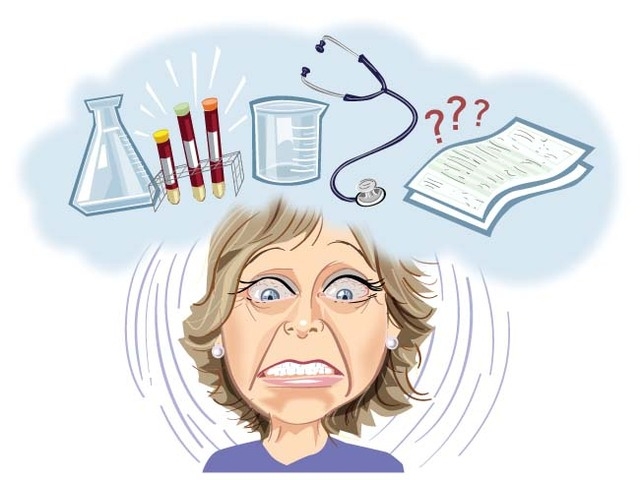New regulations allow patients to get lab test results quicker
Patients and impatience —often they go together like unflattering hospital gowns and exposed derrieres.
Few things can test your patience as much as waiting to learn about — and worrying over — the state of your health. And few things can trigger anxiety more than the eternity (or so it sometimes seems) between getting medical tests and receiving the results.
“Turnaround time can be a problem,” says Dr. Meena Vohra, a pediatric critical care specialist and medical director of Children’s Hospital of Nevada at University Medical Center, noting that some of the tests she orders are very specialized and there are only a limited number of laboratories around the country that can perform them.
“We have certain labs sent to Cincinnati to be done,” she says. “It’s a bad experience because the parents and family are waiting anxiously, wondering what’s going to happen to their child. You have to calm them down. If I have to make a call to Cincinnati and say, ‘Do you have a preliminary report, anything?’ sometimes I have the family sitting right there next to me so they know I’m not pooh-poohing them.”
In February, the Department of Health and Human Services removed the necessity of the middleman — i.e., the physician — when it announced a new federal rule allowing patients to access their test results directly from laboratories, which are compelled to release them upon request, via phone calls, websites and even smartphone apps.
The move amends the privacy rules under the Health Insurance Portability and Accountability Act and the Clinical Laboratory Improvement Amendments of 1988, which required patients to get the news from their physician.
While it may be a victory for patient rights, it comes with potential downsides.
“They can be misinterpreted and create unnecessary anxiety. Information is good, and patients are absolutely entitled to it, but it’s how you interpret the information and use it that is very important,” says Dr. Mitchell Forman, a rheumatologist and academic dean of the Touro University of Nevada College of Osteopathic Medicine.
Citing what he calls “trivial abnormalities” that often crop up in tests, Forman says he can calm alarmed patients if he has the opportunity to explain the results first.
“For example, with a serum uric acid test (to determine the amount of uric acid in the blood), they can vary tremendously in terms of range,” Forman says. “Someone who has a high value or a low value, the lab results may show you that in red with a warning, but it doesn’t have the same significance of other abnormal results. Or in a urinalysis, just having a few bacteria without any other signs of infection, it could be reported as abnormal. If there is difficulty getting in touch with patients, it will exacerbate their anxiety.”
Yes, they can get too worried. Or not worried enough.
“They may think (the results) look fine and they are perfectly fine when they’re not perfectly fine, and they can jump to their own conclusions. It can swing both ways,” Vohra says. “They feel entitled to (the results), but being entitled to it and understanding what’s in your hands are totally different.”
Misinterpretation from unfettered access can be worsened even further from misinformation gleaned from the Internet, says Dr. Tanvir Hossain, an internist affiliated with Sunrise Hospital.
“I give a lab test to a patient and he has a sister-in-law or brother-in-law who Googles the information and comes up with a list of things that can cause whatever the blood test shows,” Hossain says.
“Then they’ll come to us and say, ‘I now need this test to be done because I looked it up and I could have this and that, so you need to test me for all of it.’ That can cause tension between the physician and the patient.”
With the relaxation of the rules, patients must now weigh the pitfalls of misunderstanding their own health status with the aggravations of a delay while waiting for your follow-up appointment with a doctor. Different family members in a household can cope in various and conflicting ways to the lag time, depending on whether they’re naturally optimistic or pessimistic. Patients with short fuses are more likely to call a medical office and berate the staff. Or, if a patient is in the midst of a serious illness, the stress from waiting for further test results can hinder their recovery or even worsen their condition.
Yet Forman points out that labs sending results directly to patients can also trigger liability issues over privacy under the HIPAA laws.
“What if the laboratory sends results where other people have access to it besides the patient?” he asks, citing the example of informing someone that they have a sexually transmitted disease.
“Clearly, that’s a very sensitive matter, and if I leave a message on their phone at home or contact them where other people have access, I have to assume liability for that. And I assume laboratories might also have liability regarding protected information, if it’s through a fax or phone call or information left on a voice mail.”
As reported by kaiserhealthnews.org, the announcement of the new amendment cites studies that found “physician practices failed to inform patients of abnormal test results about 7 percent of the time, resulting in a substantial number of patients not being informed by their providers of clinically significant test results.”
That raises the question of not only waiting time, but the method for informing patients. Procedures can vary from practice to practice. At Hossain’s office, it’s more or less a no-news-is-good-news philosophy. If a test result comes back as abnormal, patients are called. If not, they aren’t.
“Some people will forget this and will call us and say, ‘I didn’t get a call, that means you guys didn’t check and you don’t care about me,’ ” Hossain says. “We just tell them, ‘Your labs are fine, we’re just waiting for you to come back the next time so we can talk.’ People think we don’t care. But if we called everyone who had blood tests, that’s a lot of time and resources.”
That doesn’t cut it by Forman’s standards.
“That kind of thing disturbs me,” Forman says. “It’s still the physician’s responsibility and it’s as good as your system is. There are times that labs get lost, or patients get lost in the system. I have one lab that is very quick getting stuff back to us, and another that isn’t so quick. So I tell patients, ‘If you haven’t heard back from us in X amount of days, call and make sure we’ve gotten the results.’ ”
While Vohra notes that physicians are very busy — she says she sees about 20 to 30 patients daily — she also advocates a courtesy call.
“I’ve heard that a lot, that if you don’t hear from us everything is good,” she says. “I think it would help a patient, good (news) or bad, to get a phone call.”
As a way to ease patients’ minds at Touro, Forman cites what he calls “patient portals” at the clinic, in which patients can contact their physician with questions about lab results and other issues online and get a “fairly quick” response, either electronically or over the phone. Should the tests show abnormalities, the physician tells the patient they can discuss it in greater detail at a follow-up, except in a “life-threatening” situation.
“Sure, you want patients to come back to the office — and generate another fee — for an interpretation of the lab results, but that doesn’t have to be the case,” says Forman, who remains ambivalent over the new rule to release test results, mainly because of what he’s seen with some patients.
“I’m amazed at how little patients know about their own health,” he says. “I’ve seen patients who have scars from their neck down to their belly button and they have no idea why (a surgery) was done. Probably a quarter of the patients I see for the first time don’t know their medications or their dosages. Yet when they look for a toaster oven, they’re much better consumers.
“I’m all about empowering patients and transparency in health care and patient advocacy,” he says. “But I have very mixed feelings about this.”























